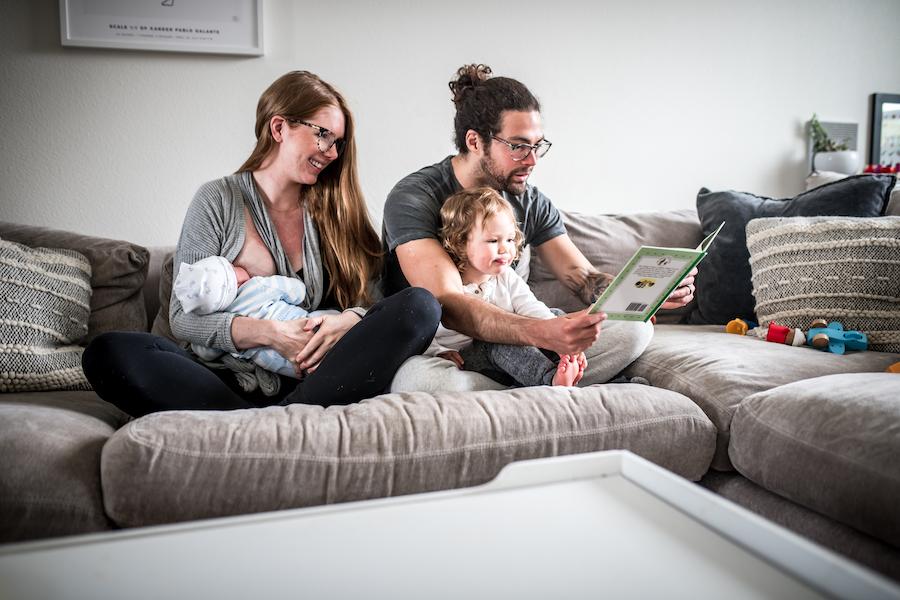The best advice we can give women who want to breastfeed is to prepare before your baby arrives. Being prepared improves your chances of a successful breastfeeding start.
Below are some tips on how you can prepare, both mentally and physically.
Breasts The fact that the breasts become larger, the areola larger and/or darker, and that they may feel tender and tight, indicates that the breasts are preparing for breastfeeding.
Some may start leaking a slightly yellowish substance called colostrum from the breasts. This can happen as early as week 16 for some. For others, it may occur towards the end of pregnancy and for some, no colostrum may appear until the child is born.
You can try hand-expressing colostrum during pregnancy, starting from week 37+, to practise and feel the sensation. Here's how:
- Wash your hands with soap and water.
- Stroke lightly over the breast from the chest towards the nipple. This may help you relax.
- Shape your fingers into a "C" just outside the outer edge of the areola.
- Using a "C" grip, move your fingers towards the chest, then press them together and move them towards the nipple. Move your fingers around the areola to stimulate the entire breast.
- Be gentle; it should not be painful.
- You can stimulate each breast for 6–10 minutes, twice a day.
Note: If you express milk, the amount or when colostrum appears does not affect milk production and breastfeeding after the child is born.
If you collect drops of breast milk, you can freeze them in a medicine cup with a lid or in a 1-millilitre syringe, labelling it with your name, personal identification number, and date. Put the medicine cup/syringe in a small freezer bag and place it in the freezer. When it's time to go to the delivery room to give birth, bring the medicine cup/syringe with colostrum in a cooler bag with an ice pack (which can be stored for 24 hours) and inform your midwife at the delivery room that you have colostrum with you.
After giving birth, have skin-to-skin contact with the baby, ensuring open airways, for the first two hours. Let the baby find its way to the breast and breastfeed before any supplementary feeding during this time. Offer the breasts first. If the baby needs supplementation, provide fresh colostrum first and thawed colostrum second. Administer colostrum with a teaspoon or medicine cup to the baby.
Taking care of the breasts becomes even more crucial during breastfeeding. Consider not wearing a tight or constrictive bra and keep the breasts warm if it feels comfortable.
Sleep To start, your infant will feed a little and often, with as many as 10 to 12 feedings—or more—over a 24-hour period. Your newborn also needs to feed at night (all babies are different) so you will most likely get little sleep the first couple of weeks. Take every opportunity to rest during the day and sleep when your baby sleeps.
Household chores and other matters can wait or be done by a partner if you have one. Give priority to rest and sleep. It pays off both in terms of breastfeeding and the wellbeing of you, your baby and your family.
Breastfeeding fear If you feel scared and worried about breastfeeding, either because you’ve had a tough experience before, or because you think it seems off-putting to nurse, speak with your midwife at the clinic. If she doesn’t have the time or knowledge to help, all breastfeeding clinics in Sweden welcome women for consultations to prepare during pregnancy. The goal is not always to breastfeed exclusively. You can also breastfeed some of the time, or create a plan so that you get off to a good start and the newborn period is a positive experience for you and your newborn infant. It’s up to you to set your goal for yourself.
If you’ve nursed before Regardless of what previous breastfeeding experiences were like, it is extremely important to remember that each one is unique. The baby you are expecting now is different from your first or earlier children, with a different personality and different circumstances. There’s no reason to compare nursing experiences. If you’re experience was good and breastfeeding worked smoothly, then you have a sound base to feel confident that this one will be fine too. If your previous experience was less than favorable, speak with your midwife during your pregnancy or schedule an appointment at a breastfeeding clinic to prepare mentally. Regardless, this breastfeeding experience will be different and there is no reason why things should not work out.
Good to have at home
- You will notice that breastfeeding makes you thirsty. It’s a good idea to have beverages at home that you like, such as juice, smoothies, soups, and more. You will need high-calorie beverages (breastfeeding requires a lot of calories). Drinking only water will not be enough.
- You do not need to buy nursing pillows and special chairs. A regular firm pillow usually offers enough support to rest your arm on. Start with the armchair, couch or bed that you have and try out different positions that suit you and your baby. If you then feel like you need to buy something, do so.
- Some women want to have a nursing pad in their bra, like a paper or wool pad, that gathers milk that leaks before and after nursing.
After the birth It helps to know how a newborn infant reacts, your newborn’s instincts and needs, how baby will respond and the best way to start breastfeeding.
